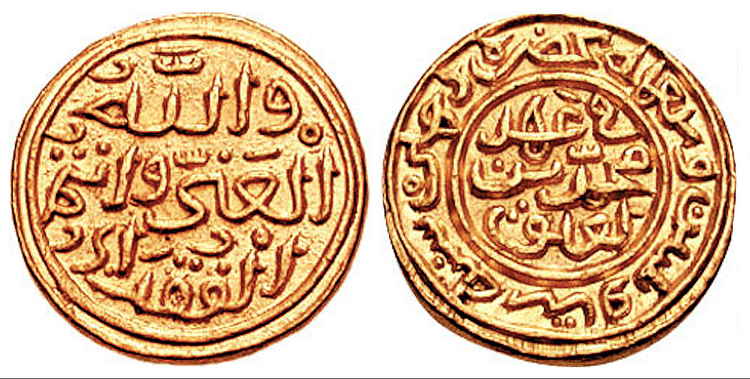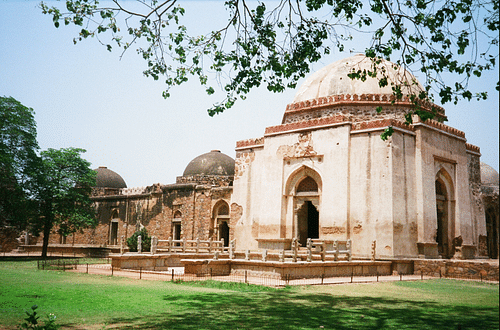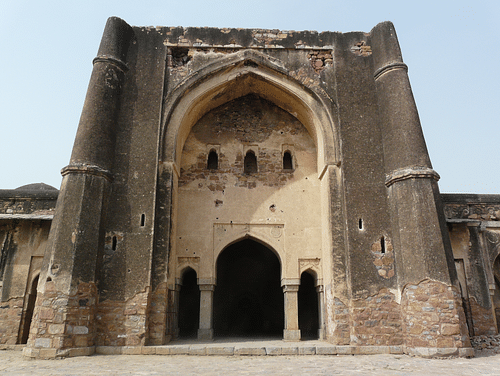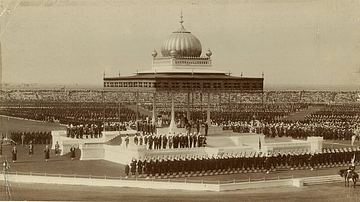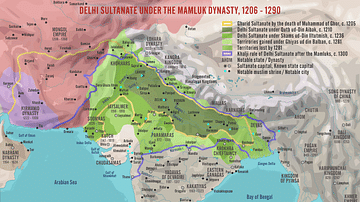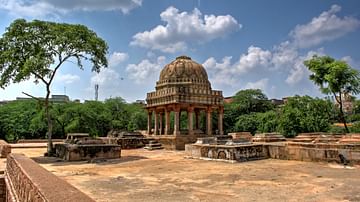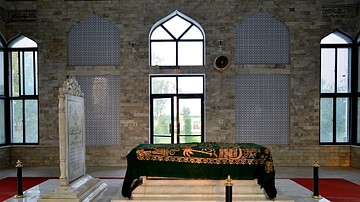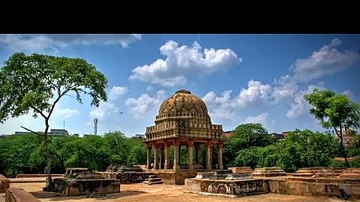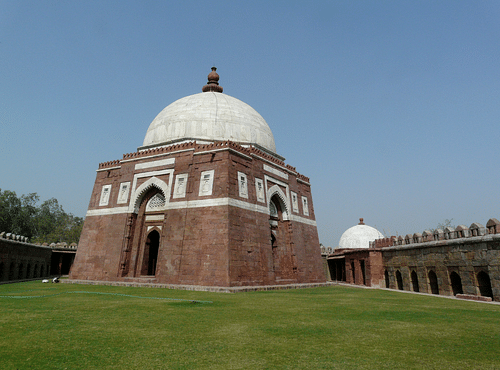
The Tughlaq Dynasty (also spelt Tughluq), ruled the Delhi sultanate from 1320 to 1413. Followed by the Khalji dynasty and preceded by the Sayyids, the Tughlaq dynasty formed an important period in the history and culture of the Sultanate. Economic life accelerated due to the establishment of karkhanas or factories, and irrigated canals facilitated agriculture. Inland and maritime trade increased and quickened the process of urbanization. Urban centers, schools, mosques, and public buildings also proliferated.
The Delhi Sultanate
In 1192 the victory of Muhammed of Ghur over the Rajput King, Prithviraj Chauhan III (r. c. 1177-1192) led to an alien rule being established in the Indian subcontinent. Shamsuddin Iltutmish (r. 1210-1236) styled himself as Sultan in 1206, and the Delhi Sultanate continued until 1526 when Ziauddin Babur (1483–1530) defeated Ibrahim Lodi (r.1517-1526). The Delhi Sultanate's rulers followed the Islamic faith.
A period of consolidation began in the 13th century. Queen Raziya (r. 1236-1240), the first woman Muslim ruler of India, received from her father Iltutmish a vast kingdom. Ghiyasuddin Balban (r. 1265-1286) ruled with an iron hand with the divine right theory of kingship. The Khalji period (1290- 1320) marked the beginning of the ascendancy of Indian Muslims and their empire even extended up to southern India. The rule by the Tughlaqs, Sayyids (1414-1451), and Lodis (1451-1526) witnessed the gradual weakening of the Delhi Sultanate.
There was religious harmony among ordinary people, although there was conflict among elites. The Sufi and Bhakti saints emphasized religious harmony and the equality of humankind. The new technique of Indo-Islamic architecture witnessed the construction of beautiful arches, domes, and gardens. The Urdu language was emerging with the amalgamation of dialects of Hindi and Persian. There was also a proliferation of vernacular literature. There was, too, an exchange of diplomatic missions, even with China. Thus, the reign of the Delhi Sultans formed a crucial period in the history of the Indian subcontinent.
The contemporary historical writings of Ziauddin Barani (Tarikh-i-Firuz Shahi and Fatwa-i-Jahandari), Ibn Battuta (The Rihla), and Shams Siraj Afif (Tarikh-i-Firuz Shahi) provide source materials for studying different aspects of the Delhi Sultanate.
Ghiyasuddin Tughluq
Ghiyasuddin Tughluq (aka Ghiyath al-Din Tughluq, r. 1320-1325) was the founder of the Tughluq dynasty. He was governor of the northwest provinces at the time of Nasiruddin Khusrav Shah (r. 1320), a Hindu convert. The Turk tribes did not reconcile to the rule of a converted Muslim as they believed in the superiority of the Turkish race. Ghiyasuddin gathered around him the nobility and became the Sultan after deposing Khusrav. He suppressed the recalcitrant Hindu Rajas and undertook a policy of territorial aggrandizement. In 1323, the Telingana kingdom in south India was annexed. The Tughluq army plundered Jajnagar in Odisha. East and south Bengal were incorporated into the Sultanate while north Bengal remained a vassal state under Nasirudddin Ibrahim.
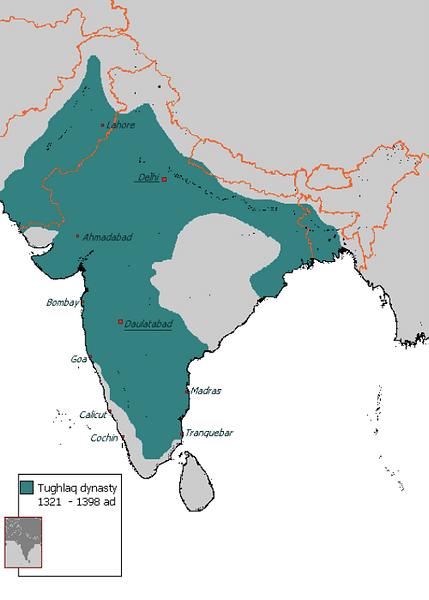
As a capable military commander, the Sultan revamped the army organization making it battle-ready. The soldiers were well-looked and Ghiyasuddin pursued a paternalistic policy towards peasants. Agriculture was also improved and revenue officers were explicitly ordered not to be harsh with cultivators. Means of communication also improved a great deal. Bridges, roads, and canals were constructed. The postal system became more efficient. The Sultan had a fair sense of justice and he prohibited inhuman punishment, but thieves and corrupt revenue officials were not spared. On a personal level, the Sultan was a strict disciplinarian and strict follower of Islamic laws, eschewing alcohol as well as worldly pleasures.
The Sultan died in 1325 due to the collapse of a wooden pavilion built in his honour. It was believed that his son, Jauna Khan had a hand in the accident. On the whole, Ghiyasuddin was a successful Sultan. He had extended the kingdom's boundaries, looked after the people's welfare, and filled up the state treasury.
Muhammad Bin Tughluq
Muhammad Bin Tughluq (r. 1325-1351) became the Sultan of Delhi after his father's death, Ghiyasuddin Tughluq even though he has been blamed for his father's death by some historians. The Sultan believed in the Divine Right theory of kingship. Following a liberal policy, he appointed officials irrespective of caste, creed, or religion. He also did not discriminate against his Hindu subjects. Muhammad Tughluq undertook a policy of conquest and sent expeditionary forces to Khurasan, Nagarkot, Qarajal, Mewar, Telingana, and Malabar. Diplomatic relations were established with many Asian countries. His empire was the most extensive one among the medieval Sultans.
The projects of the Sultan were far ahead of his time but these often failed due to improper execution and the unpopularity of the schemes. The creation of another capital in Daultabad, taxation in the Doab region, introduction of token currency, etc., created great hardship for his subjects and invited opposition. With the best of intentions, the Sultan's experiments were grand failures. His reign period witnessed dissent and rebellions. The governors of the northwestern province and Bengal were given harsh punishments. Independent kingdoms came into existence, such as Malabar, Vijayanagar, and Bhamani. At the time of his death in 1351, the disintegration of the Delhi Sultanate had already begun. Although he had ruled over a vast empire, the Sultan was not able to hold it together. The learned, liberal and tolerant Sultan, the most controversial figure of medieval India, failed as a ruler. He was not schizophrenic as has been alleged but, averse to any advice, the Sultan could not measure his subjects' pulse.
Feroz Shah Tughluq
The cousin of Muhammad Tughluq, Feroz (or Firuz) Shah Tughluq, ascended the throne in 1351 and ruled until 1388. Although not a capable military leader like his predecessors, the Sultan was a great builder of cities, monuments, and public buildings. The Sultan imposed the four taxes sanctioned by the Islamic laws, including a tax on non-Muslims, Jeziya. Depending on the priestly classes or the ulemas, the state was intolerant towards the zimmmis (non-Muslims) and the Shias. His campaign to Jajnagar (Odisha) in 1361 destroyed the famous Puri Jagannatha temple. Firuz did not attempt to retrieve the territories lost in the previous reign and his military organization was fragile. His fondness for keeping a large retinue of slaves resulted in the depletion of the state coffers.
Firuz, a patron of learning, established 30 madrasas (Islamic schools) and three colleges. Although intolerant of the Hindus, he ordered the translation of religious scriptures into Persian. His humanitarian measures included the building of orphanages and charitable hospitals. His construction activity included establishing scores of towns, undertaking irrigation works, and digging public wells. Firuz took special care in maintaining and repairing famous monuments like the Qutb Minar, Jama masjid, and mausoleums of some of the earlier sultans. Jaunpur, Hissar, Fatehabad, and Firozpur were just some of the urban centers which thrived in the Sultan's reign. Firuz resided in the newly built city of Firuzabad in Delhi, and its ruins, Firoz Shah Kotla, are extant. The Sultan's last days were not happy due to civil wars and in-fighting over the future of the throne; the death of his eldest son Faterh Khan in 1374 made him almost senile. His grandson Tughluq Shah (r. 1388-1389) became the next Sultan after his death.
The Last Tughluq Sultans
The experiments of Muhammad Tughluq, the weakness of Firuz, the incompetent successors that followed, the depletion of state resources, and the wars in south India were all responsible for the ultimate downfall of the Tughluq dynasty. Tughlaq Shah was assassinated by nobles proclaiming loyalty to his cousin, Abu Bakr Shah (r.1389-1390). Muhammad Shah (r. 1390-1393) in turn, deposed Abu Bakr. By the time of the ruler Mahmud Nasiruddin (r. 1393-1394), the Tughluq Empire covered an area of just seven miles from Delhi to Palam. Alauddin Sikandar, son of Muhammad Shah then ruled for some months in 1394. His younger brother Nasir Muhammad Shah (r.1394-1412) was the last member of the Tughlaq dynasty. The sack and plunder of Delhi by the Mongol chief Timur (1336-1405) in 1398 was the last blow from which the dynasty did not recover.
Indo-Islamic Architecture under the Tughluqs
Islamic architecture had developed considerably from the first Islamic building of Kaba and the Grand Mosque surrounding it. When Islam came to the Indian subcontinent, a new era began. Islam was confronted with an existing style of architecture that was very old and developed. Gradually, there was a synthesis of Hindu and Muslim styles, and Indo-Islamic architecture developed its own identity. The city of Delhi was the primary focus of the architecture of the Sultanate.
Indo-Islamic architecture developed further under the Tughluqs. Among the imposing structures built by the Sultans were the city of Tughlaqabad, Firozabad, the tomb of Firuz, and others. Ghiyasuddin Tughluq built the fortress city of Tughlaqabad in Delhi between 1321 and 1325. It was the capital, and a strong fortress designed for defense. The palace-fortress enclave was constructed by checking the Jamuna river flow, resulting in the creation of an artificial lake, which surrounded the city in the eastern direction of the fort. Tughlaqbad occupied a massive area of rectangular shape, encompassed by walls ranging from 15 to 30 meters with a thickness of about 10 meters. The bastions having two stories and gargantuan towers, surrounded the palace, audience halls, tombs, and mosque. The sloping walls, called batter, were a novelty of Tughlaqabad.
The mausoleum of Ghiyasuddin Tughluq was located on the southern side of the fortress. Built by the Sultan, the tomb is in the shape of a pentagon surrounded by fortified walls with an angle of 75 degrees. Built of red sandstone with a dome of white marble, the archways present a perfect combination of arch and beam, blending the trabeate and arcuate method. The interior, containing the sarcophagus, has a single chamber surmounted by a dome.
A legend mentions the discord between the Sultan and the Sufi saint, Khwaja Nazimuddin Auylia (1236-1325), which was responsible for the demise of the Thughalaqbad. Ghiyassuddin could not reach the capital from Bengal and was killed when the wooden pavilion built in his honour collapsed. The Sultan did not permit the workers to be employed by the Saint, who uttered the famous prophecy, Hunuz Dilli dur ast (Delhi is yet far away).
Muhammad Tughluq constructed the Royal residence of Jahanpanah along with the Begumpuri mosque. Another passionate builder, Firuz Shah Tughluq constructed many towns, mosques, reservoirs, pavilions, and bridges. His newly built fortress city of Firoz Shah Kotla is extant amid ruins. The old fort-city of Tughlaqabad was abandoned, and the new capital city of Firoz Shah Kotla was constructed with a rectangular plan of about 800 by 400 metres (2624 x 1312 ft). A fortified stone wall surrounded the town with the main entrance on the western side. It encompassed the quarters of the guards and soldiers, a rectangular-shaped Mahall-i Bari Amm (Palace of the Public Court), and a square pillared hall for transacting the private business of the Sultan. On rectangular and square-shaped courts stood residential quarters of the Royalty, Hawa Mahall (palace of the winds), Kushk-i-Shikar (hunting place), mosque pigeon-tower, baoli (stepped well), and exquisite gardens with running water and fountains. The Sultan's abode was Kushk-i-Feroze. Friday prayers were offered in the public mosque or Jami masjid, with its spacious courtyard and series of cells.
One of the city's unique features is the pillar of Mauryan Emperor Ashoka (r. c. 268 - c. 232 BCE), raised on a three-tiered pyramid-like structure. It was removed from its original location in the Topra district of Ambala, Haryana. The pillar, encased in reed and raw animal skins, was moved with the help of a 42-wheel carriage drawn by about 200 people. On the banks of the river Jamuna, it was ferried and carried to the present location. In 1356, stone friezes were placed around it.
Finally, the Feroz Shah Kotla has been used as a cricket ground by the Delhi District Cricket Association since November 1948. The stadium was named after Arun Jaitley, an Indian politician, in 2019.
The period of the Tughluqs forms an important period in the history and culture of the Delhi Sultanate. Economic life accelerated due to the establishment of karkhanas or factories (trading centers) by Firuz. The inland and maritime trade increased and quickened the process of urbanization. Urban centers, schools, mosques, and public buildings also proliferated. The contemporary historical writings of Ziyauddin Barani (Tarikh-i-Firuz Shahi and Fatwa-i-Jahandari) and Shams Siraj Afif (Tarikh-i-Firuz Shahi) provide additional source materials for studying different aspects of the Delhi Sultanate.

